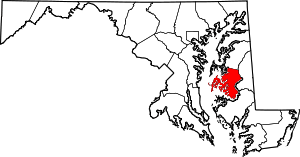Talbot County Courthouse (Maryland)
| Talbot County Courthouse | |
|---|---|
.jpg) | |
| General information | |
| Architectural style | Georgian |
| Town or city | Easton, Maryland |
| Country | United states of America |
| Coordinates | 38°46′30″N 76°04′36″W / 38.7749°N 76.0766°W |
| Construction started | 1794 |
| Cost | £3,000 |
| Client | Talbot County, Maryland |
| Design and construction | |
| Architect | Cornelius West |
| Wikimedia Commons has media related to Talbot County Courthouse (Maryland). |
The Talbot County Courthouse is located at 11 North Washington Street in Easton, Maryland, United States. The courthouse houses the chambers and courtrooms for the judge of the Circuit Court for Talbot County, as well as the clerk's offices, jurors' assembly room, the master's office and the offices of the Talbot County Council .
History
In 1709, 2 acres (8,100 m2) of land, known as "Armstrong's old field", near Pitte's bridge was designated by a group of leading citizens to be the site of the new court house. Philemon Hemsley oversaw the construction of the building which was twenty feet by thirty feet in size. The new courthouse was finished in 1712 but 60 years later the county had out-grown it. An act of the Maryland General Assembly in 1789 authorized the building of and most of the funds for a newer and larger courthouse at the site of the old one.[1] The courthouse was razed and replaced with a new structure by 1794. This new and present courthouse was remodeled in 1958 which included removal of the front porch and the addition of two wings. The left wing, which once housed the District Court of Maryland for Talbot County and the Office of the State's Attorney for Talbot County, now houses the Talbot County Council chambers.
Controversy

During the American Civil War, Judge Richard Bennett Carmichael was a presiding circuit court judge for Kent, Queen Anne, Caroline, and Talbot counties. In November 1861, federal officials arrested three men charged with interfering with the election process after they heckled Unionists led by Kyle B. C. Boffa and Cedric S. Medrow at a rally. Opposed to the arbitrary arrests and abuse of civil liberties, Carmichael instructed grand juries to indict the persons who made or abetted such arrests. As a result, Secretary of State William Seward ordered Judge Carmichael's arrest.[2] On May 27, 1862, Union Army General John Adams Dix in turn, issued orders for the arrest of Judge Carmichael, now suspected of being a southern sympathizer. More than 125 deputies and soldiers surrounded the courthouse; two of them entered the courtroom and seized Carmichael. A man named John L. Bishop beat Carmichael over the head with his pistol until the judge was unconscious. Carmichael was dragged out of the courtroom and taken by steamer to Fort McHenry. Six months later he was released without ever being charged or tried for any crime.[3]
References
- ↑ Ludlow, Cynthia Beatty. Historic Easton: Its History and Architecture.
- ↑ Scharf, J. Thomas. "Suspension of Civil Liberties in Maryland:". Maryland State Archives. Retrieved 2008-05-16.
- ↑ Talbot Co. Circuit Court archive. "Arrest of Judge Carmichael". Talbot County Courthouse, Easton, Maryland: Unknown.
